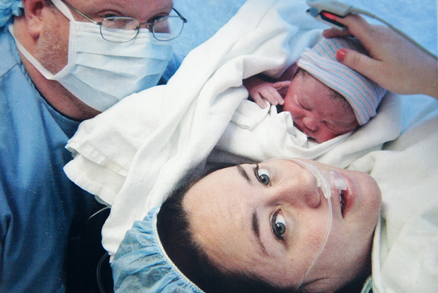July 13, 2015
Elective Induction at 40 Weeks? "Decision-Based Evidence Making" Strikes Again
By: Henci Goer, BA | 0 Comments
Today on Science & Sensibility, contributor Henci Goer takes a look at a systematic review released in spring that examined the impact of elective inductions on the cesarean rate. Sound analysis or a house of cards? Looking closer at the studies reviewed provides insight into how the conclusions reached by the investigators might need to be examined more closely. Henci does that in this review. Have you read this new systematic review? Did you come to the same conclusions? I invite you to share your thoughts in our comments section below. - Sharon Muza, Community Manager, Science & Sensibility.

flickr photo by catharticflux
http://flickr.com/photos/catharticflux/2710057340
CC licensed.
Yet another systematic review has surfaced "Induction of labor at full term in uncomplicated singleton gestations: a systematic review and metaanalysis of randomized controlled trials" in which reviewers claim that electively inducing healthy women, this time at 40, not 41 weeks, offers benefits and doesn't increase the cesarean surgery rate (Saccone 2015).
Let's take a closer look.
Reviewers included five trials: three of them conducted in the 1970s (Cole 1975; Martin 1978; Tylleskar 1979), the fourth published in 2005 (Nielsen 2005), and the fifth in 2014 (Miller 2014). Already we have a problem. Induction management in the 1970s is sufficiently different from management today that results are unlikely to apply to contemporary care, but let's get down to specifics. Two of the 1970s trials were deemed inadequate for inclusion in the Cochrane review of elective induction (Gulmezoglu 2012), and Miller 2014 is published only as an abstract. Quality systematic reviews exclude abstracts because they don't provide enough information to evaluate the study. For these reasons, these three trials should be taken off the table..
That leaves us with the other two. Nielsen 2005 states in the title "Comparison of elective induction of labor with favorable Bishop scores versus expectant management: a randomized clinical trial" that it is confined to women with favorable Bishop scores. Anyone familiar with elective induction research should know that inducing when the cervix is ready to go won't increase the cesarean rate compared with spontaneous onset, but inducing with an unripe cervix is a different story even when using cervical ripening agents (Dunne 2009; Jonsson 2013; Le Ray 2007; Macer 1992; Prysak 1998; Thorsell 2011; Vahratian 2005). As you move the induction date earlier and earlier, more and more women will have an unfavorable cervix, so including a trial limited to women with a ripe one will tilt the playing field in favor of induction. Furthermore, half the participants were multiparous women (113/226). Women with prior vaginal births will go on having vaginal births pretty much no matter what you do to them, which raises another point: inducing earlier means a higher percentage of the inductees will be first-time mothers because first time mothers tend to run longer pregnancies (Mittendorf 1990). Nulliparous women are much more vulnerable to anything that pushes them in the direction of a cesarean. That's not all: The authors tell us that their hospital has a 7% cesarean rate for dystocia in women at term. If a hospital has a cesarean rate much higher than that-and many do-then results can't be generalized to it, although, frankly, if the doctors are performing cesareans left and right, induction or spontaneous onset may not make much difference. In short, Nielsen (2005) doesn't make a compelling argument for 40-week elective induction.

flickr photo by Selbe
http://flickr.com/photos/stacylynn/11944718954
shared under a Creative Commons (BY-NC-ND) license
This brings us to the last trial, Cole (1975). Investigators allocated healthy women either to induction at 40 weeks (111 women) or 41 weeks (117 women). As with Nielsen, half the women had prior vaginal births. Despite being healthy, 22 women were induced for "obstetric complications" (undefined) in the 41-week induction group before reaching 41 weeks. If their doctors induced labor because they had concerns, then this would likely put the women at heightened risk for cesarean. Another 32 women were induced for exceeding 41 weeks. This means that overall, nearly half (46%) of the comparison group didn't begin labor spontaneously, which would mask any association between induction and cesarean. Leaving the induction vs. spontaneous onset issue aside, the U.S. cesarean rate in the early 1970s was around 5%, which means it was a rare woman who would have one regardless of circumstances. Again, not exactly a strong case for inducing at 40 weeks.
What about the benefits? The best reviewers can come up with are a clinically meaningless reduction in mean blood loss (-58 ml); a lower rate of meconium-stained amniotic fluid (4% vs. 14%), not, mind you, a reduction in meconium aspiration, and therefore clinically meaningless as well; and an equally meaningless reduction in mean birth weight of -136 g (5 oz). If they had found something more impressive, surely they would have reported it.
Really? This merited a pre-publication media blast? Because it amounts to a textbook example of "garbage in, garbage out." I can see only three possibilities to explain it: either 1) the authors and peer reviewers at the American Journal of Obstetrics and Gynecology (AJOG) don't know as much as they should about what constitutes a quality systematic review, 2) they are so steeped in medical model thinking-"How early can we get the baby out of that treacherous maternal environment?"-that their judgment is compromised, or 3) we have a "pay no attention to what's behind the curtain" effort to promote elective induction. I don't know which is the more troubling, but if it's the last one, the sad thing is that because it's got the magic words "systematic review," "meta-analysis," and "randomized controlled trials" in the title, it's likely to succeed.
References
Cole, R. A., Howie, P. W., & Macnaughton, M. C. (1975). Elective induction of labour. A randomised prospective trial. Lancet, 1(7910), 767-770.
Dunne, C., Da Silva, O., Schmidt, G., & Natale, R. (2009). Outcomes of elective labour induction and elective caesarean section in low-risk pregnancies between 37 and 41 weeks gestation. J Obstet Gynaecol Can, 31(12), 1124-1130.
Gulmezoglu, A. M., Crowther, C. A., Middleton, P., & Heatley, E. (2012). Induction of labour for improving birth outcomes for women at or beyond term. Cochrane Database Syst Rev, 6, CD004945.
Jonsson, M., Cnattingius, S., & Wikstrom, A. K. (2013). Elective induction of labor and the risk of cesarean section in low-risk parous women: a cohort study. Acta Obstet Gynecol Scand, 92(2), 198-203. doi: 10.1111/aogs.12043
Le Ray, C., Carayol, M., Breart, G., & Goffinet, F. (2007). Elective induction of labor: failure to follow guidelines and risk of cesarean delivery. Acta Obstet Gynecol Scand, 86(6), 657-665.
Macer, J. A., Macer, C. L., & Chan, L. S. (1992). Elective induction versus spontaneous labor: a retrospective study of complications and outcome. Am J Obstet Gynecol, 166(6 Pt 1), 1690-1696; discussion 1696-1697.
Martin, D. H., Thompson, W., Pinkerton, J. H., & Watson, J. D. (1978). A randomized controlled trial of selective planned delivery. Br J Obstet Gynaecol, 85(2), 109-113.
Miller, N., Cypher, R., Pates, J., & Nielsen, P. E. (2014). Elective induction of nulliparous labor at 39 weeks of gestation: a randomized clinical trial. Obstet Gynecol,132(Suppl 1):72S.
Mittendorf, R., Williams, M. A., Berkey, C. S., & Cotter, P. F. (1990). The length of uncomplicated human gestation. Obstet Gynecol, 75(6), 929-932.
Nielsen, P. E., Howard, B. C., Hill, C. C., Larson, P. L., Holland, R. H., & Smith, P. N. (2005). Comparison of elective induction of labor with favorable Bishop scores versus expectant management: a randomized clinical trial. J Matern Fetal Neontal Med, 18:59-64.
Prysak, M., & Castronova, F. C. (1998). Elective induction versus spontaneous labor: a case-control analysis of safety and efficacy. Obstet Gynecol, 92(1), 47-52.
Saccone, G., & Berghella, V. (2015). Induction of labor at full term in uncomplicated singleton gestations: a systematic review and metaanalysis of randomized controlled trials. American journal of obstetrics and gynecology.
Thorsell, M., Lyrenas, S., Andolf, E., & Kaijser, M. (2011). Induction of labor and the risk for emergency cesarean section in nulliparous and multiparous women. Acta Obstet Gynecol Scand, 90(10), 1094-1099. doi: 10.1111/j.1600-0412.2011.01213.x
Tylleskar, J., Finnstrom, O., Leijon, I, et al. (1979). Spontaneous labor and elective induction - a prospective randomized study. Effects on mother and fetus. Acta Obstet Gynaecol Scand, 58:513-518.
Vahratian, A., Zhang, J., Troendle, J. F., Sciscione, A. C., & Hoffman, M. K. (2005). Labor progression and risk of cesarean delivery in electively induced nulliparas. Obstet Gynecol, 105(4), 698-704.out
About Henci Goer

Henci Goer, award-winning medical writer and internationally known speaker, is the author of The Thinking Woman's Guide to a Better Birth and Optimal Care in Childbirth: The Case for a Physiologic Approach, She is the winner of the American College of Nurse-Midwives "Best Book of the Year" award. An independent scholar, she is an acknowledged expert on evidence-based maternity care.
Tags
Breastfeeding Induction Cesarean Cochrane ACOG Labor/Birth Henci Goer Decision-Making Facebook Evidenced based teaching better birth outcomes better pregnancies Changing health care practice childbirth professional Fear in Childbeaing Year Bishop's Score